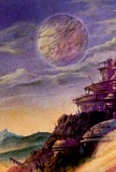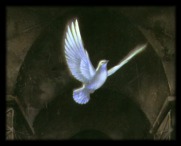

These are the reviews from April through August of 1998. For newer reviews, go back to the main book page.
 As the middle book of a new Foundation trilogy, Greg Bear's
Foundation and Chaos has a tricky role to fill. While the story
is well-constructed and masterfully told, the constraints of following
Foundation's Fear but leaving room for a third book (to be written
by David Brin) hold back Bear's usual creativity.
As the middle book of a new Foundation trilogy, Greg Bear's
Foundation and Chaos has a tricky role to fill. While the story
is well-constructed and masterfully told, the constraints of following
Foundation's Fear but leaving room for a third book (to be written
by David Brin) hold back Bear's usual creativity.
In this book, an elderly Hari Seldon trying to manage critical events in the development of the foundation, and in the accelerating fall of the Empire. Meanwhile, the ancient robot R. Daneel Olivaw shapes larger events. Some other familiar characters from previous Foundation novels make their appearances, but the new character portraits are the real treat. This book includes a detailed, fully explained version of the famous courtroom scene from Isaac Asimov's original 1951 Foundation. The original was told mostly from the viewpoint of new arrival Gaal Dornick, in Greg Bear's reprise, we get to see the viewpoint of Hari Seldon himself. Most of the story threads in this book converge for this climactic confrontation between Hari and the imperial commission for public safety, and for Hari's exquisite pronouncement of doom for the empire. Along the way, Bear paints character of Linge Chen himself for us, the hard and cunning de facto ruler of the galaxy.
Another fascinating aspect of the book is its treatment of robots. One of the main characters becomes entangled in a power struggle between different factions of the secret robot culture. Greg Bear's creative scope is obliquely revealed here, in the brief depiction of the struggle of small groups of robots to continue to serve humanity from hiding over thousands of years. This and other themes in the book present a nice contrast between groups working for humanity's future, and individuals working for personal power.
Despite the need to stick fairly close to story elements imposed by Isaac Asimov and Gregory Benford, Greg Bear manages to serve us an intricate and absorbing story. It is a fitting centerpiece for the new trilogy, and continues the high standard set by the first book. David Brin certainly has his work cut out for him, writing the conclusion for the new trilogy - personally, I can't wait.
Conclusion: Recommended
The writing style in this book is similar to that of some other fine scientists that have taken up popularization: Sagan, Gould, Gamow, and others. Scholarly and witty by turns, the text flows well but is not light reading. The density of information is high.
Any history of science has to cover certain major topics: gravity, evolution, electricity, thermodynamics, genetics, and quantum mechanics. In addition to these de rigeur areas, the author has chosen to explore several other areas of physics, chemistry, and biology. The treatment of chaos is rather good. As might be expected from a chemist, the description of the transition from alchemy to modern chemistry is very well presented. The author also incorporates personal notes and feelings very nicely, in a manner that reminded me a little of Murray Gell-Mann.
In attempting to explain the ascent of science, Brian Silver set himself a huge task. As long as the book is, it takes a few shortcuts. In general, the text basically assumes that the reader already has a fair grounding in history and culture, with a smattering of science, mathematics, and philosophy. While the book certainly addressed a breadth of scientific issues, in many sections there seemed to be a mismatch between the depth of of the science presented, and the depth of non-science background expected of the reader.
As an account of scientific ideas and their context, The Ascent of Science is wonderful, a unique achievement. In the broader view, as a book for the general reader, it is less successful.
Conclusion: Conditionally Recommended
The protagonist, Blacktooth St. George, is a monk at a monastery of the order of the blessed Liebowitz. The scene is the american southwest, several hundred years after humanity is nearly wiped out in a nuclear war. Blacktooth is not well suited to the monastic life. Events conspire to push him out into the political and social strife surrounding a succession in the Papacy. Early in these adventures, he falls for a mysterious young woman, and his love for her adds further conflict and doubt to his already troubled faith. The plot is rich and complex, and the major characters are masterfully portrayed.
Underlying the events and twists in the plot are several themes that also appeared in Miller's first novel: the nature of faith, conflicts in human societies, and the role of loyalty in human affairs. Where Canticle explored these themes in a series of linked vignettes, Miller's new work intertwines them with a very detailed portait of a single momentous event.
Miller is nothing if not honest, and adult sexuality and the horrors of war both appear in this novel in rather graphic form. It is definitely not suitable for the prudish or overly sensitive.
Even more honestly, the author never really answers the deep questions about religion and faith that are posed to the characters. Instead, the reader is left to figure them out for himself or herself.
St. Liebowitz and the Wild Horse Woman is being sold as a sequel, but chronologically it falls in between to sections of its predecessor. It is really more of a revisiting than a sequel, much smaller in scope, but more detailed and focused. One question on my mind as I purchased this book was: would it measure up to its highly regarded predecessor? In the end, it cannot. Perhaps an author only gets one such inspiration in a career. While this novel stands on its own, it is much better enjoyed in context: if you haven't already read A Canticle for Liebowitz, then read it first (it's back in print). If you find the themes and style of that classic to your liking, then continue with Saint Liebowitz and the Wild Horse Woman.
Conclusion: Conditionally Recommended
 Many intelligent, well-read
adults bemoan their lack of understanding of mathematics.
Ivars Peterson has taken up the challenge of explaining
mathematical ideas in a readable and entertaining form.
His most popular book, The Mathematical Tourist, was
a series of wonderfully clear and cogent forays into
different branches of math. Somewhat more focused,
The Jungles of Randomness takes the reader on
jaunts to explore statistics, probability, order, and chaos.
Peterson tied each mathematical idea to an application
in biology, physics, or some other area.
Some of the topics covered include:
Many intelligent, well-read
adults bemoan their lack of understanding of mathematics.
Ivars Peterson has taken up the challenge of explaining
mathematical ideas in a readable and entertaining form.
His most popular book, The Mathematical Tourist, was
a series of wonderfully clear and cogent forays into
different branches of math. Somewhat more focused,
The Jungles of Randomness takes the reader on
jaunts to explore statistics, probability, order, and chaos.
Peterson tied each mathematical idea to an application
in biology, physics, or some other area.
Some of the topics covered include:

Helpful black-and-white illustrations pepper the text, although some chapters might have benefited from a few more of them. A small number of very good color plates are collected in the center of the book. For readers interested in pursuing some of the topics further, an excellent set of references is provided, organized by chapter.
Conclusion: Recommended
The main character, Julian Class, is a special kind of soldier: a tele-operator of a nearly invincible war machine called a "soldierboy." He is also "jacked," or equipped with an implant that lets him share the thoughts of his platoon members and communicate with them mind-to-mind. As the war he is fighting gets nastier and more complex, he becomes involved in a scheme to forestall a very serious threat to the entire solar system. To describe the plot any further might ruin some of the surprises, but the book reaches social and emotional depths that are exceptional for military science fiction.
The title, Forever Peace, reminds the reader of Haldeman's 1974 classic The Forever War. Despite their somewhat similar titles, the books have nothing in common besides their treatment of futuristic warfare and its implications. While the writing in Forever Peace is more mature and sophisticated than the author's award-winning early work, the poignancy and power seems somehow diminished. (Note: if you haven't read The Forever War, drop whatever you're doing and get it.)
 Lastly, Joe Haldeman is not delicate
in describing the violence and social decay of Julian Class's
existence. None of the graphic descriptions are gratuitous,
however, and they serve to make the book's bittersweet
conclusion all the more moving.
Lastly, Joe Haldeman is not delicate
in describing the violence and social decay of Julian Class's
existence. None of the graphic descriptions are gratuitous,
however, and they serve to make the book's bittersweet
conclusion all the more moving.
Conclusion: Recommended
The 1001 well-explained facts are grouped into fifteen chapters, organized roughly by increasing distance from the Earth. The chapters about planetary and stellar astronomy are the strongest and best written. For the most part, Dr. Gutsch doesn't shrink from explaining difficult concepts (e.g. facts 640-646, about Cepheid variables), but while the explanations are good, the format of the book prevents the wonder of astronomy from showing as well as it can in more traditional narratives.
Readers who are already well-informed about astronomy may find this book somewhat tedious, but for reader new to the field it may provide welcome breadth. As the former Chairman of the Hayden Planetarium, Dr. Gutsch has obviously had plenty of practice explaining astronomy to the public, and it shows. The text is fairly well supported with grayscale photographs, and scattered the black-and-white diagrams are also helpful. More detailed diagrams and color plates would have been welcome. A full index is provided, but sadly there is no bibliography.
Conclusion: Lightly Recommended
All reviews (c) 1998, Neal Ziring. Reviews may be reproduced in whole or
in part as long as authorship credit is preserved.
[Ziring
MicroWeb Home] [Neal
Ziring] [Julie
Ziring]
[Ziring Guestbook]
This page written by Neal Ziring, last modified 8/18/98.